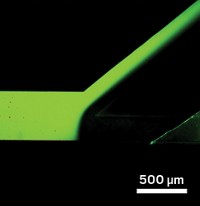Advertisement
Grab your lab coat. Let's get started
Welcome!
Welcome!
Create an account below to get 6 C&EN articles per month, receive newsletters and more - all free.
It seems this is your first time logging in online. Please enter the following information to continue.
As an ACS member you automatically get access to this site. All we need is few more details to create your reading experience.
Not you? Sign in with a different account.
Not you? Sign in with a different account.
ERROR 1
ERROR 1
ERROR 2
ERROR 2
ERROR 2
ERROR 2
ERROR 2
Password and Confirm password must match.
If you have an ACS member number, please enter it here so we can link this account to your membership. (optional)
ERROR 2
ACS values your privacy. By submitting your information, you are gaining access to C&EN and subscribing to our weekly newsletter. We use the information you provide to make your reading experience better, and we will never sell your data to third party members.
Diagnostics
Spinning a tool from a toy
A fidget spinner centrifuge separates plasma from blood well enough for diagnostic testing
by Leigh Krietsch Boerner, special to C&EN
February 1, 2019

One might be tempted to judge the ubiquitous fidget spinner, twirled endlessly between the fingers of school kids, as a mere toy. However, it has an unforeseen beneficial purpose, says a team of researchers. The device can act as a makeshift centrifuge, able to separate blood plasma to 99% purity. Just a couple of flicks of the spinner were sufficient to get enough pure plasma to test for HIV (Anal. Chem. 2018, DOI: 10.1021/acs.analchem.8b04860).
When doctors run blood tests, they need to separate blood cells from the desired plasma. Generally, they use a centrifuge, in which high speed rotation sediments blood cells, says study author Chien-Fu Chen of the Institute of Applied Mechanics at National Taiwan University. “Although centrifuges can produce extremely pure plasma samples, these instruments are expensive and require electricity to operate, which may not be feasible in resource-limited regions of the world,” he says.
Along with colleague Chien-Cheng Chang, Chen put human blood spiked with a common HIV-1 diagnostic protein in 50 mm long plastic tubes, sealed them, and taped the tubes to each of the three spinning arms of a commercially available fidget spinner. After spinning the device for four to seven minutes, they found they were able to retrieve about 30% of the plasma out of the blood sample—with 99% purity. To see if the blood was sufficiently separated to run diagnostic tests, they ran a paper-based HIV test on the separated plasma. The test was able to pick up the target proteins. Chen noted that this makeshift centrifuge could be used to detect other diseases with plasma biomarkers as well. And if the blood is not separated enough, just give the fidget spinner another spin. The tube is transparent, he says, so you can see the separation progress easily.
“It’s wonderful for people to be thinking about these types of approaches,” says Manu Prakash, a bioengineer at Stanford University whose team developed a paper-based whirligig centrifuge that can also separate blood plasma. “They’re incredibly important to people around the world.” Every contribution to “frugal science is extremely valuable,” he adds.
The spinning speed for a fidget spinner is a bit slow, Prakash points out, which makes the total spinning time to separate blood a bit longer than with his group’s whirligig one, for instance. “But in the end, the most important thing is lighting up people’s imagination,” Prakash said. “The fact that solutions can exist in unusual places is frankly as important sometimes as the solutions themselves.”
CORRECTION: This article was updated on Feb. 7, 2019, to reflect that the blood samples were spiked with an HIV-1 protein commonly used in HIV diagnosis, not the complete HIV-1, and to clarify that the tubes used were plastic





Join the conversation
Contact the reporter
Submit a Letter to the Editor for publication
Engage with us on Twitter